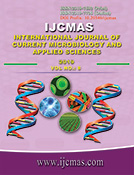


 National Academy of Agricultural Sciences (NAAS)
National Academy of Agricultural Sciences (NAAS)

|
PRINT ISSN : 2319-7692
Online ISSN : 2319-7706 Issues : 12 per year Publisher : Excellent Publishers Email : editorijcmas@gmail.com / submit@ijcmas.com Editor-in-chief: Dr.M.Prakash Index Copernicus ICV 2018: 95.39 NAAS RATING 2020: 5.38 |
Present study was carried out to evaluate toxic effect of cadmium chloride at 15, 50 and 100 ppm in drinking water for 28 days on liver, kidney, heart and intestine in male rats. Twenty-four male albino rats (270 to 340 g, 4 weeks of age) were randomly divided in to 4 groups having 6 animals in each group. The animals of control group received distilled water throughout the experimental period, while rats of other three groups received either 15, 50 or100 ppm of CdCl2 in drinking water for consecutive 28 days. Haematological and biochemical parameters, histopathological evaluation and status of oxidative stress markers were observed at the end of study. Alterations in ALT, AST, AKP and BUN of rats of all three toxic groups were dose dependant. SOD activity (U/mL) was significantly increased (p < 0.05) in serum and liver while decreased in kidney and intestine of all toxic groups as compared to control. Activity of catalase in blood (molar/min) was significantly decreased (p < 0.05) in all groups as compared to control. Catalase activity (U/mg protein) in liver, heart and intestine were significantly decreased as compared to control in dose dependant way. However, significant decrease in catalase activity was observed in kidney at high level of exposure to cadmium. The level of GSH (g/mg of tissue) was significantly decreased in tissues at higher level of exposure. Histopathological analysis revealed that liver, kidney, heart and intestine showed changes in dose dependent manner. In conclusion, cadmium at 100 ppm caused marked alterations to multiple organs through oxidative damage in rats following continuous exposure for 28 days.
 |
 |
 |
 |
 |